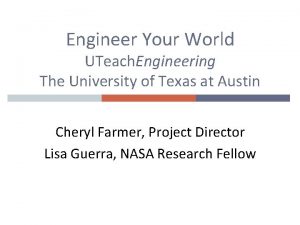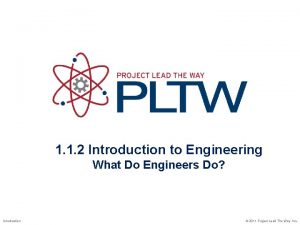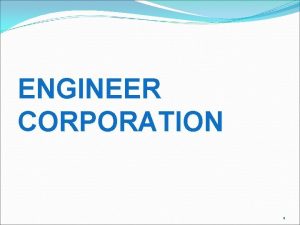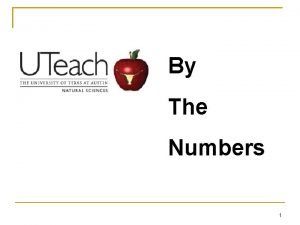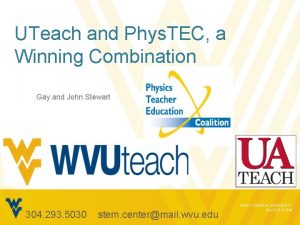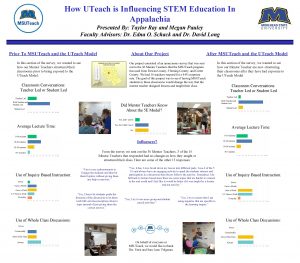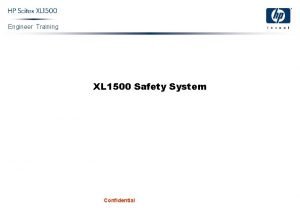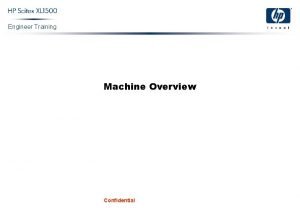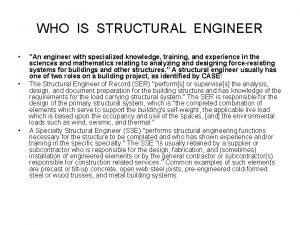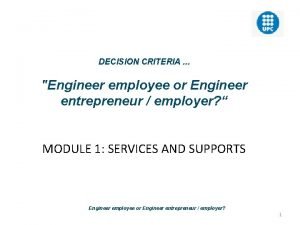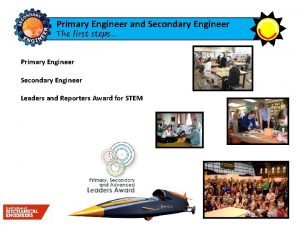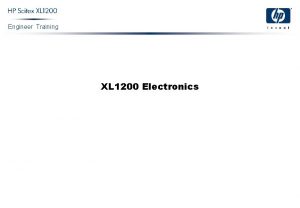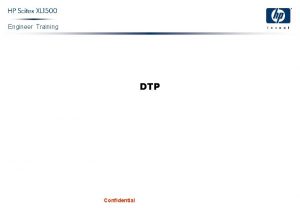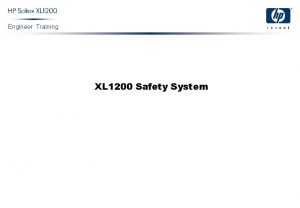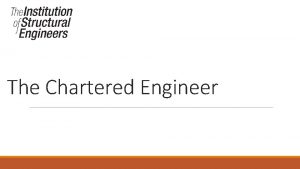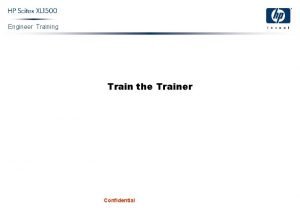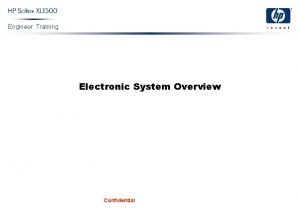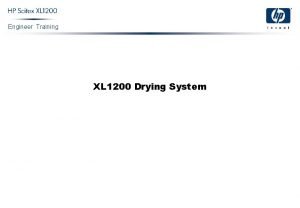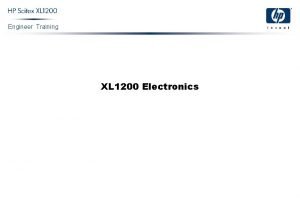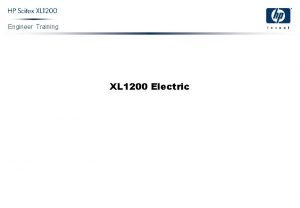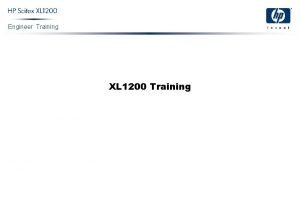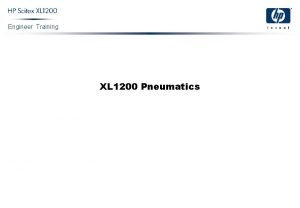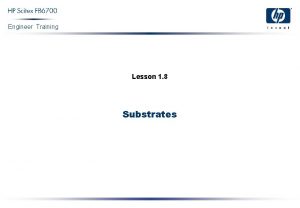Engineer Your World UTeach Engineering The University of






































- Slides: 38

Engineer Your World UTeach. Engineering The University of Texas at Austin Cheryl Farmer, Project Director Lisa Guerra, NASA Research Fellow

Presentation Overview q What is UTeach. Engineering? q Overview q Texas Pilot and Early Results q Pilot Phase Two q 2014 and Beyond

Presentation Overview q What is UTeach. Engineering? q Overview q Texas Pilot and Early Results q Pilot Phase Two q 2014 and Beyond

What is UTeach. Engineering? + + q Funded by the National Science Foundation (NSF) through a $12. 5 M grant from the Math-Science Partnership (MSP) program q Grant period of performance: 2008 -2013 q One of three NSF MSP grants focusing on K 12 engineering education q A unique partnership designed to n n (Short-term) Respond to the current opportunity in Texas (4 x 4 requirement) (Long-term) Develop and evaluate a model for addressing national engineering needs

What is UTeach. Engineering? q A model high school engineering course and supporting professional development q Teacher preparation – degree programs n n q In-Service: Master of Arts in Science and Engineering Education (MASEE) Pre-Service: BS programs for STEM majors pursuing teaching certification Meaningful research in an emerging field

Presentation Overview q What is UTeach. Engineering? q Overview q Texas Pilot and Early Results q Pilot Phase Two q 2014 and Beyond

Features q Engages students in authentic engineering practices q Project-based environment n 80% hands-on activity n 20% documenting and reflecting on work, preparing presentations and reports, participating in direct instruction Actively engages students in engineering practices (p 18)

Features q Student learning scaffolded over six design challenges n n Standardized engineering design process Requires purposeful application of engineering principles and relevant science and math concepts Deepen understanding of concepts shared across STEM (p 19) q Aligned with Texas state standards and emerging Next Generation Science Standards Coherent set of standards and curriculum (p 19)

Course Framework

Course Framework Student Learning Outcomes Engineering design projects related to core ideas in the discipline (p 19)

Course Framework Engineering Design Process Engineering design projects related to core ideas in the discipline (p 19)

Active engagement (p 18) Related to core ideas (p 19) Unit 1: Reverse Engineer Your World Engineering impacts our everyday lives. Functional models Research Information gathering Reverse engineering

Active engagement (p 18) Related to core ideas (p 19) Unit 2: The Evolution of Imagery Engineers design products to satisfy customer wants and needs. The engineering design process New design Design evolution Design embodiment Performance verification Engineering notebooks

Active engagement (p 18) Related to core ideas (p 19) Unit 3: Aerial Imaging Engineers work in teams to solve complex design challenges. Teamwork Project management System decomposition Design at the subsystem level Requirements Concept generation and selection Ethics and safety

Active engagement (p 18) Related to core ideas (p 19) Unit 4: Green Energy for Clean Water Engineers improve lives. System context and top-down perspective Developing performance targets Appropriate instrumentation Design modification Performance verification Formal documentation Greatest engineering achievements

Active engagement (p 18) Related to core ideas (p 19) Unit 5: The Search for Lunar Ice Engineering opens frontiers. Automation and control Programming basics Operations planning Engineering’s grand challenges

Active engagement (p 18) Related to core ideas (p 19) Unit 6: Culminating Design Challenge Engineers in all disciplines solve open-ended design challenges. More complex unit; less structured Student-directed design process Includes all engineering critical aspects Focuses on STEM professions Introduces risk analysis Introduces project management skills

Presentation Overview q What is UTeach. Engineering? q Overview q Texas Pilot and Early Results q Pilot Phase Two q 2014 and Beyond

2011 -12 Pilot Districts 90, 000 Not Economically Disadvantaged 80, 000 Number of Students 70, 000 Economically Disadvantaged 60, 000 50, 000 40, 000 30, 000 20, 000 10, 000 0 Austin ISD 84, 245 students (63. 5 % ED) Dripping Springs ISD 4, 311 students (13. 2 % ED) Plano ISD 54, 683 students (23. 6 % ED) Round Rock ISD 42, 777 students (28. 7 % ED) School of Excellence in Education 2085 students (78. 9 % ED)

2011 -12 Pilot Schools 3, 000 Not Economically Disadvantaged 2, 000 Crockett HS 1, 732 students (61. 1 % ED) Recognized Reagan HS 866 students (88. 3 % ED) Recognized Mc. Callum HS 1, 751 students (38. 7 % ED) Dripping Springs Plano HS HS 1, 235 2, 664 students (11 % ED) (8. 3 % ED) Acceptable Bowie HS 2, 805 students (12. 7 % ED) Acceptable 0 Acceptable 500 Acceptable 1, 000 Acceptable 1, 500 Recognized Number of Students 2, 500 Stony Point HS 2, 535 students (33. 8 % ED) Milton B Lee Academy of Science 216 students (78. 7 % ED)

Pilot Teachers # Sections Offered # Students in 2011 -12 Pilot Course Other Courses Taught Years Teaching Experience Engineering Degree or Experience Bowie HS (R) 1 24 Physics 20 No Crockett HS (A) 1 9 Physics 15 No Mc. Callum HS (A) 1 10 CAD 10 No Reagan HS (A) 1 7 Physics 4 Dripping Springs HS (R) 1 22 Statistics 10 4 (2 teachers) > 120 Physics 5 and 2 2 60 Physics 16 Campus (Rating) Plano HS (R) Stony Point HS (A) No

Early Results from 2011 -12 Pilot q Teachers struggled to complete the course in their first year (to be expected) n n q Need to establish classroom norms early in the course n n q Generally completed 80 -85% of the course (Units 1 -5) Should be able to cover more as materials become familiar General norms Engineering norms (collaboration, communication) Need to modify and strengthen scaffolding n n Reorder introduction of certain skills Reinforce key concepts consistently across units

Presentation Overview q What is UTeach. Engineering? q Overview q Texas Pilot and Early Results q Pilot Phase Two q 2014 and Beyond

Teacher Professional Development Two-week workshop to enhance participants’ engineering content knowledge and pedagogical Teachers’ capabilities and content knowledge to teach content and subject matter (p 21) q Features: q n n n Content aligned to course and underlying standards Appropriate for teachers from diverse backgrounds Emphasizes active engagement and problem-solving Conveys clear ideas about effective teaching and learning Offers frequent opportunities for Addresses teachers’ classroom work (p 21) critical reflection on teaching

Mentor Program for Teachers q Developing and testing mentorship model for scale n n q In-person engineer mentors for teachers from n n q Mentor PD in conjunction with teacher PD Ongoing SIG for participants NASA space flight centers NASA affiliates (e. g. , Washington Museum of Flight, Colorado’s Shades of Blue) Benefits to teacher and students n n Support teacher in first year, assist with “tough” spots Offer classroom visits and additional resource (e. g. , facility tours, access to industry/government design challenges)

Developing Validated Assessments q Rubrics for assessing student performance q Rubrics for assessing student artifacts n Major focus in 2012 -13 n Internal and external experts n Develop rubrics n Assure inter-rater agreement among experts n Pilot with teachers Supportive system of assessment - internal to course (p 21)

Presentation Overview q What is UTeach. Engineering? q Overview q Texas Pilot and Early Results q Pilot Phase Two q 2014 and Beyond

Enhancement and Expansion q Advanced Placement (AP) Option n n q Current portfolio option aligned to draft AP requirements Anticipated for credit in 2014 -15 Expanding Network n n n NASA’s Space Grant Consortium NSTA Regional Meetings — Engineering Days State Departments of Education

Developing Courseware: LMS + Virtual Collaboration Tool M 1 M 2 MX … • Mentor/mentor collaboration • Teacher/mentor collaboration T 1 T 2 … TX • Teacher/teacher collaboration • Teacher-student communication S 11 … S 1 N 1 S 21 … S 2 N 2 … SX 1 … SXNX • Student/student collaboration

Developing Courseware: LMS + Virtual Collaboration Tool S 11 M 2 … MX T 1 T 2 … TX … S 2 N 2 … … S 1 N 1 S 21 SX 1 … SXNX Multiple and sustained opportunities for teacher learning over time (p 21) Interaction and collaboration with colleagues (p 21) For teachers, access to • Course Materials • Lesson plans • Background materials • Supporting resources • Ongoing PD • Refresher videos • On-time training • Webinars on practice • Course Management Tools • Share resources with students • Assign, view, assess student work • Collaboration Tools • Teacher-to-teacher • Teacher-to-mentor

Developing Courseware: LMS + Virtual Collaboration Tool M 1 M 2 T 1 S 11 … S 1 N 1 S 21 MX … T 2 … … S 2 N 2 … TX SX 1 … SXNX For mentors, access to • Course Materials • Lesson plans • Background materials • Supporting resources • Teacher PD Materials • Refresher videos • On-time training • Collaboration Tools • Mentor-to-mentor • Mentor-to-teacher

Developing Courseware: LMS + Virtual Collaboration Tool M 1 M 2 T 1 S 11 … S 1 N 1 S 21 MX … T 2 … … S 2 N 2 … TX SX 1 … SXNX For students, access to • Course Materials • Background materials and supporting resources shared by teacher • Assignments • Virtual Engineering Notebook • Document work for self • Submit work to teacher • Prepare portfolio for AP or admissions • Collaboration Tools • Student-to-student • Student-to-teacher

Presentation Overview q What is UTeach. Engineering? q Overview u d e. xas e t u. l i a m @ r e 6 9 m 1 g r r 6 a o f. . 1 l d 7 y l r r 4 e o 2 h w c r 51 g u r o o y. r g e in e r n e i g e n in e g. n w e ww uteach. w w w q Texas Pilot and Early Results q Pilot Phase Two q 2014 and Beyond

Backup Slides Why Teach Engineering? Why Now?

The National STEM Conversation is Happening Now q Rising Above the Gathering Storm, Revisited: Rapidly Approaching Category 5 (9/2010) q Report to the President – Prepare and Inspire: K-12 Education in STEM for America’s Future (9/2010) q Change the Equation, a CEO-led initiative to cultivate widespread STEM literacy (9/2010)

National Policy Picture q In the national STEM conversation, what is the role of engineering? How can engineering be more than the “silent E” in “STEM”? Engineering in K-12 Education National Academy of Engineering (NAE), 2009 Standards for K-12 Engineering Education? NAE, 2010 Integrating engineering standards; to be reviewed & released, 2012

National Need Proficient , Interested (17%) 2 7% of HS freshmen STEM Major Proficient, Not Interested (25%) 2 Not Proficient (68%) 3 4, 013, 000 beginning 9 th grade in 20011 Not Proficient , Interested (15%) 2 Non-STEM Major Not Proficient , Not Interested (42%) 2 2 -Year College 2, 799, 000 graduates in class of 20051 Graduate with STEM Major 4% of HS freshmen College Grad Career 278, 000 STEM majors of 1, 170, 000 enrolled in 4 -year college 1 167, 000 STEM graduates expected in 20111 Sources: (1) Gates Foundation, NCES Department of Education Statistics; Science and Engineering Indicators 2008. (2) BHEF U. S. STEM Education Model, February 2010. Based on ACT’s “College Ready” definition, which is different from NAEP proficiency. (3) NAEP Mathematics 2009 national results, grade 8.

National Need
 Engineer your world
Engineer your world Which engineer may design a gps for your vehicle
Which engineer may design a gps for your vehicle Give us your hungry your tired your poor
Give us your hungry your tired your poor Hình ảnh bộ gõ cơ thể búng tay
Hình ảnh bộ gõ cơ thể búng tay Lp html
Lp html Bổ thể
Bổ thể Tỉ lệ cơ thể trẻ em
Tỉ lệ cơ thể trẻ em Voi kéo gỗ như thế nào
Voi kéo gỗ như thế nào Chụp tư thế worms-breton
Chụp tư thế worms-breton Alleluia hat len nguoi oi
Alleluia hat len nguoi oi Các môn thể thao bắt đầu bằng tiếng nhảy
Các môn thể thao bắt đầu bằng tiếng nhảy Thế nào là hệ số cao nhất
Thế nào là hệ số cao nhất Các châu lục và đại dương trên thế giới
Các châu lục và đại dương trên thế giới Công thức tính thế năng
Công thức tính thế năng Trời xanh đây là của chúng ta thể thơ
Trời xanh đây là của chúng ta thể thơ Cách giải mật thư tọa độ
Cách giải mật thư tọa độ Làm thế nào để 102-1=99
Làm thế nào để 102-1=99 độ dài liên kết
độ dài liên kết Các châu lục và đại dương trên thế giới
Các châu lục và đại dương trên thế giới Thơ thất ngôn tứ tuyệt đường luật
Thơ thất ngôn tứ tuyệt đường luật Quá trình desamine hóa có thể tạo ra
Quá trình desamine hóa có thể tạo ra Một số thể thơ truyền thống
Một số thể thơ truyền thống Cái miệng nó xinh thế
Cái miệng nó xinh thế Vẽ hình chiếu vuông góc của vật thể sau
Vẽ hình chiếu vuông góc của vật thể sau Nguyên nhân của sự mỏi cơ sinh 8
Nguyên nhân của sự mỏi cơ sinh 8 đặc điểm cơ thể của người tối cổ
đặc điểm cơ thể của người tối cổ Thế nào là giọng cùng tên
Thế nào là giọng cùng tên Vẽ hình chiếu đứng bằng cạnh của vật thể
Vẽ hình chiếu đứng bằng cạnh của vật thể Tia chieu sa te
Tia chieu sa te Thẻ vin
Thẻ vin đại từ thay thế
đại từ thay thế điện thế nghỉ
điện thế nghỉ Tư thế ngồi viết
Tư thế ngồi viết Diễn thế sinh thái là
Diễn thế sinh thái là Dot
Dot Bảng số nguyên tố lớn hơn 1000
Bảng số nguyên tố lớn hơn 1000 Tư thế ngồi viết
Tư thế ngồi viết Lời thề hippocrates
Lời thề hippocrates Thiếu nhi thế giới liên hoan
Thiếu nhi thế giới liên hoan
